When Gaming Meets Smart Data Strategy
Date Published

In the competitive landscape of digital products, the challenge isn't just creating engaging features—it's designing experiences that deliver dual value. How do you provide genuine user benefit while simultaneously gathering actionable insights for your business? LinkedIn's recent launch of daily brain games offers a masterclass in this delicate balance, transforming casual gaming into a sophisticated data collection strategy.
The games appear simple on the surface: addictive, challenging puzzles that provide daily brain training. But beneath this engaging exterior lies a brilliant example of how smart UX design can create valuable user personas while keeping customers genuinely satisfied.
The Data-Driven Gaming Revolution: What LinkedIn Really Captures
LinkedIn's gaming feature isn't just about entertainment—it's a sophisticated behavioral analysis tool. Through seemingly innocent daily puzzles, the platform captures multidimensional user data:
.png&w=3840&q=100)
• Learning Curve Analysis - How quickly users adapt to new challenges
• Persistence Levels - User tenacity when facing difficult problems
• Competitive Nature - Willingness to engage in social comparison
• Logical Thinking Patterns - Problem-solving approaches and strategies
• Sharing Behaviors - Propensity to broadcast achievements
• Cognitive Style - Individual thinking and processing preferences
• Behavioral Diversity - Range of interaction patterns across different game types
Each gaming session contributes to a comprehensive user persona—a detailed behavioral fingerprint that reveals far more than traditional surveys or forms ever could.
The Smart UX Framework: Value Exchange in Action
The genius of LinkedIn's approach lies in the principle of reciprocal value creation. Users receive genuine entertainment and cognitive benefits, while LinkedIn gains unprecedented insights into user psychology and behavior patterns.
The 3 Stage Value Exchange Process:

Stage 1: Engagement Design
Create features that provide immediate, tangible value to users. The games offer:
- Daily mental stimulation
- Achievement satisfaction
- Social connection opportunities
- Cognitive skill development
Stage 2: Data Harvesting
Seamlessly collect behavioral insights through natural user interactions:
- Time spent on different puzzle types
- Success rates and retry patterns
- Social sharing frequencies
- Difficulty preference patterns
Stage 3: Insight Application
Transform collected data into actionable business intelligence:
- Personalized content recommendations
- Targeted advertising strategies
- Product development insights
- User segmentation refinement
Real-World Application: Implementing Smart Data Collection
Case Study: The Birthday Discount Strategy
Consider a simple but effective example: offering birthday discounts. This seemingly generous gesture creates a perfect value exchange:
User Value: Special recognition and monetary savings
Business Value: Critical demographic data (age) for marketing segmentation
This illustrates how thoughtful feature design can simultaneously delight customers and provide valuable business intelligence.
Key Questions for Your Product Strategy:
1. Are you collecting smart information through your existing features?
2. Do your user interactions provide genuine value while returning actionable data?
3. How can you design features that users want to engage with repeatedly?
4. What behavioral patterns could reveal valuable insights about your user base?
Implementation Guidelines for Product Teams
1. Design with Dual Purpose
Every feature should serve both user needs and business intelligence goals. Ask:
- What value does this provide to the user?
- What insights can we gather from user interactions?
- How can we make data collection feel natural and non-intrusive?
2. Focus on Behavioral Data
Move beyond basic demographics to capture:
- Usage patterns and preferences
- Decision-making processes
- Social interaction styles
- Learning and adaptation rates
3. Create Engagement Loops
Design features that encourage regular interaction:
- Daily challenges or rewards
- Progressive difficulty levels
- Social comparison elements
- Achievement systems
4. Ensure Ethical Data Use
Maintain user trust through:
- Transparent data practices
- Clear value propositions
- Respect for privacy preferences
- Meaningful user benefits
Conclusion: From Features to Strategic Assets
LinkedIn's gaming initiative demonstrates a fundamental shift in product thinking: features should be strategic assets that generate both user satisfaction and business intelligence. When you design your next feature, resist the temptation to focus solely on immediate revenue generation.
Instead, consider the long-term value of smart data collection. Well-designed user interactions can reveal behavioral patterns, preferences, and tendencies that inform everything from product development to marketing strategy. This behavioral intelligence, when properly analyzed and applied, ultimately translates into sustainable competitive advantage and revenue growth.
The most successful products of the future will be those that master this dual-value creation—providing genuine user benefit while building a comprehensive understanding of their customer base. LinkedIn's games aren't just entertaining; they're building the foundation for more personalized, effective, and profitable user experiences.